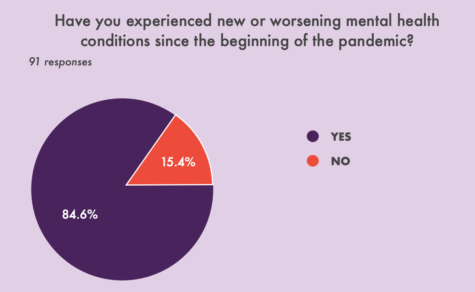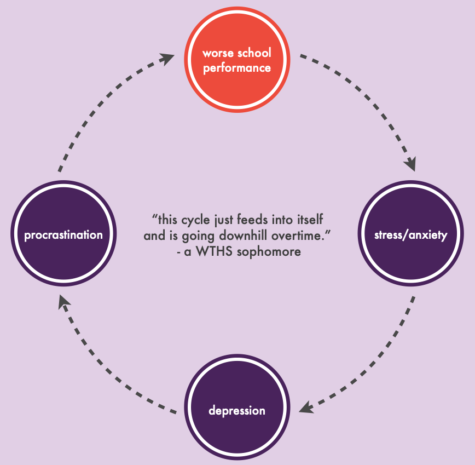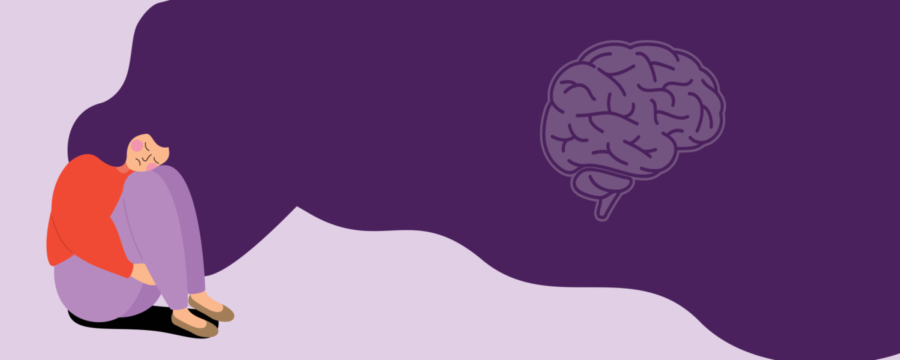The QuaranTEEN Mental Health Crisis
April 5, 2021
Anxiety. Fear. Depression. Considered “silly” to most older generations, these are the most common words used by teens when asked to describe what they have taken away from school. In the past year, school districts across the nation have been reporting alarming spikes in both suicides and attempts at self-harm. The other major event that occurred this past year? The pandemic.
Although there are many other factors contributing to the mental health decline in “QuaranTeens” (a pop-culture term for teens surviving through the COVID-19 pandemic), a recent survey conducted at Warren Township High School shows that 85% of student respondents listed “School” as a contributing factor to their worsening mental health. Contrary to popular belief, for the most part, this is not due to school closures, but rather school continuation.

Education, although vital and beneficial to every student, is retained differently by each individual. The worldwide lockdown is no excuse for learning and education to be halted or even slowed down, but it does mean that it should be carried out differently than what was being done prior to the virtual format. Situated in different environments, not all students have a quiet room with top-notch Wi-Fi, or location optimum for virtual learning. Bringing in other factors that have served as potential stressors, including family issues, having to take care of siblings, fear/uncertainty, and financial issues, there has been a hindrance to their efforts in attending 8-hour virtual classes from Monday-Friday. On top of all this, students are being held to the same expectations in performance as they were prior to this new format.
We, as developing teenagers trying to learn from our elders and our surroundings, are being thrown out into this unfamiliar world with the assumption that rising technology can solve all our problems. However, like all educators out there, we also have never experienced a 100% technology environment or used our devices for educational purposes besides watching a video or viewing a website for information on a specific topic. With so much information being lost due to the lack on interpersonal communication between the teachers and students, we are being forced to re-learn (or even learn for the first time) through hundreds of Google searches and YouTube videos, just to pass the same tests that were being given to students who were able to clarify any information with their teachers right away. Even after doing our part, teachers, being bombarded with emails, are unable to address every individual question. This, according to our WTHS survey, is leading to incredibly high levels of anxiety, which is contributing to teenage depression, which is then resulting in a lack of motivation in numbers that have never been seen before. These increased procrastination habits are causing worse performance at school, leading to more stress and anxiety, and the whole cycle starts again.

Besides our in-school requirements, many students, including myself, are exhausted from constantly hearing the phrases “We don’t know” and “We are sorry for the cancellation of _____ for the remainder of the year/season.” Although high school students understand the uncertainty during these times and difficult decisions everyone has had to take for health and safety purposes, many have already experienced a lot of disappointment as sports, competitions, school dances, and other activities that we have either looked forward to or worked very hard for over several years, and the intensity of schoolwork is pushing us to the edge.
The Solution?
Taking over more than half of an average student’s day (including homework & test prep), schools are a fundamental part of a teenager’s developmental process. Therefore, with or without the pandemic, mental health resources should be openly discussed and promoted by every single teacher/staff member. For the remainder of the year and as schools begin to open up, students and teachers should establish a mode of communication that would allow all necessary information to be exchanged effectively.
Different methods that would allow students to anonymously share their concerns with a staff member could help struggling individuals relieve their thoughts without them feeling ashamed or feeling judged. An example includes setting up an anonymous “Call Center Booth” in the school (or a number students can call at from home) where students can sign-up to talk to a social worker without revealing their identity at that time. If there is anything that can be done to solve a student’s problem, the social worker could talk to the student to meet up, if they are comfortable, and find a solution.
These are just a few of the many solutions to this dilemma. Therefore, each school should regularly assess the psychological health of its students and implement at least one additional mental health resource to ease stress levels during these unprecedented times. Through this, schools can at least attempt make some positive changes in the mental health of their students, instead of just contributing to its decline.










